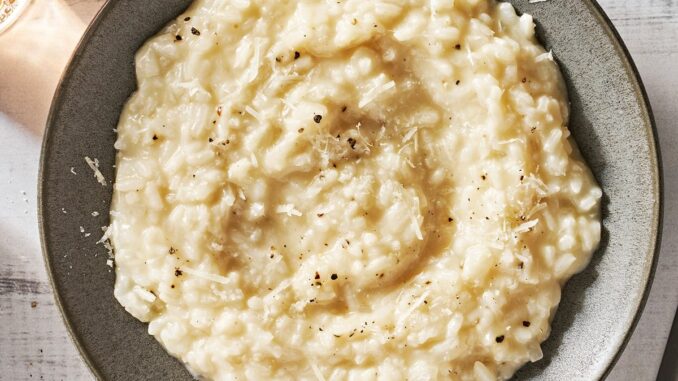
Introduction:
Risotto, a timeless Italian dish that transcends culinary boundaries, has woven itself into the fabric of gastronomic delight worldwide. This delectable rice dish, hailed for its creamy consistency and rich flavors, is a testament to the artistry of Italian cuisine. In this extensive exploration, we will delve into the fascinating history of risotto, tracing its origins and evolution through the centuries. Additionally, we will uncover the secrets of crafting the perfect risotto with a traditional recipe that captures the essence of this beloved Italian classic.
Section 1: The Roots of Risotto
1.1 Origins in Northern Italy:
Risotto’s origins can be traced back to Northern Italy, particularly the regions of Lombardy and Veneto. Historically, rice paddies were abundant in these areas, making rice a staple ingredient in local diets. The first mention of risotto dates back to the late 14th century in the Venetian cookbook “Libro de Arte Coquinaria,” signifying its early presence in Italian culinary history.
1.2 Evolution Over the Centuries:
While the basic concept of cooking rice slowly in a flavorful broth remained consistent, risotto underwent various transformations over the centuries. Initially considered a simple dish, it evolved into a canvas for culinary experimentation, with chefs incorporating diverse ingredients, creating regional variations that contribute to the rich tapestry of Italian cuisine.
Section 2: The Art of Crafting Risotto
2.1 Essential Ingredients:
The heart of any risotto lies in its ingredients. Arborio, Carnaroli, or Vialone Nano rice varieties are commonly used due to their high starch content, which contributes to the dish’s creamy texture. Broth, typically made from meat, vegetables, or seafood, forms the base, while Parmesan cheese and butter add richness.
2.2 The Technique of Soffritto:
Soffritto, a crucial step in risotto preparation, involves sautéing finely chopped onions or shallots in olive oil or butter until translucent. This aromatic base sets the stage for the rice to absorb the flavors of the dish.
2.3 Toasting the Rice:
Toasting the rice in the soffritto mixture is another critical step. This process enhances the nutty flavor of the rice and ensures that each grain is coated with the aromatic oils from the sautéed ingredients.
2.4 Gradual Broth Addition:
Risotto is characterized by the slow addition of warm broth to the rice, allowing it to absorb the liquid gradually. This method promotes the release of starches, creating the dish’s trademark creaminess. Consistent stirring during this process is key to achieving the desired texture.
2.5 The Finishing Touch:
Once the rice reaches an al dente consistency, the finishing touches come into play. Butter and Parmesan cheese are stirred in, creating a luscious, velvety texture. Additional ingredients such as saffron, mushrooms, seafood, or herbs can be added for flavor complexity.
Section 3: Regional Variations
3.1 Risotto Milanese:
Risotto Milanese, a classic variation hailing from Lombardy, is infused with saffron, providing a distinctive golden hue and a subtly earthy flavor. Often served with ossobuco, this version epitomizes the marriage of simplicity and elegance.
3.2 Risotto Nero:
Venturing to Veneto, Risotto Nero takes center stage. This striking dish, with its jet-black appearance, is achieved by incorporating cuttlefish ink. Seafood lovers revel in its intense flavors, often enhanced with shellfish and a hint of garlic.
3.3 Risotto ai Funghi:
Moving to the woodlands of Italy, Risotto ai Funghi is a mushroom-infused delight. Porcini, chanterelles, or a medley of wild mushrooms bring an earthy depth to the dish, offering a comforting and hearty experience.
Section 4: Risotto in Modern Cuisine
4.1 Creative Fusion:
In contemporary culinary landscapes, chefs globally have embraced risotto as a versatile canvas for culinary innovation. Experimental combinations, fusion interpretations, and novel ingredient pairings have elevated risotto to new heights, appealing to diverse palates.
4.2 Vegan and Health-Conscious Adaptations:
Responding to evolving dietary preferences, chefs have devised vegan and health-conscious variations of risotto. Nutritional grains, plant-based broths, and a plethora of vegetables showcase the adaptability of this classic dish to contemporary lifestyles.
Section 5: Risotto in Popular Culture
5.1 Cinematic and Literary Presence:
Beyond the culinary realm, risotto has made notable appearances in popular culture. From being featured in iconic Italian films to being celebrated in literature, the dish has transcended its culinary role to become a cultural symbol.
5.2 International Appreciation:
Risotto’s global appeal is evidenced by its integration into international culinary scenes. Restaurants worldwide feature risotto on their menus, and home cooks embrace the challenge of mastering this quintessential Italian dish.
Conclusion:
Risotto stands as a testament to the culinary ingenuity of Italy, evolving from a humble rice dish in the northern regions to a globally cherished culinary delight. Its rich history, intricate preparation techniques, and diverse regional variations showcase the depth and versatility of Italian cuisine. Whether savoring a classic Risotto Milanese or exploring modern interpretations, the appreciation for this timeless dish remains a celebration of the artistry and cultural richness embodied in every flavorful grain. As you embark on your risotto-making journey, let the history and traditions of this iconic Italian dish guide you to a culinary experience that is as rich and satisfying as the dish itself. Buon Appetito!